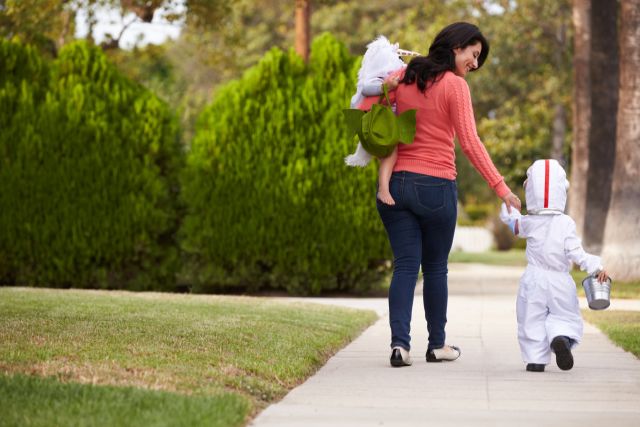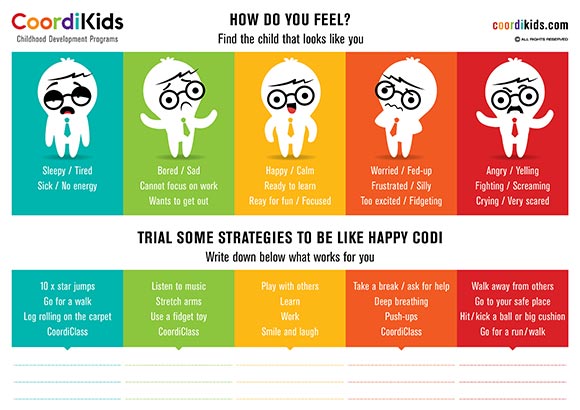General Information
Tips for the Highly Sensitive Child Parenting Strategies During Halloween
If you have a child scared of Halloween, it can make this annual event one to dread. But not this year!
Our guest, Liz London, writes about the highly sensitive child parenting strategies during Halloween. Along with tips from pediatric Occupational Therapist, Marga Grey, this lively read can make Halloween a whole lot easier – and more fun – this year!
I LOVE Halloween. I mean, I really love it. I’m one of those nutty adult Americans who decorates my whole front yard like a haunted house. I use a tiller to dig up a section of my garden to look like fresh graves. I install a spider web along the entire side of my house.
And I change out the light bulbs in most of my house in favor of green, red, and purple atmospheric lighting. I have a huge party for all my adult friends to play dress up like we were still in grade school. And we even bob for apples and throw darts at a balloon wall for prizes.

But, two things have halted my Halloween humor this year.
First, I moved to Europe, where Halloween is pretty strictly for the kiddos. And second, I now have a 3-year-old son who is over sensitive to sudden changes in sound and light.
His pediatrician says he isn’t too concerned about it being a developmental issue like Sensory Processing Disorder, but that my little guy is definitely over sensitive for his age.
Whether there was some sort of loud surprise noise that traumatized him or if there might be some other underlying cause that we’ll discover later down the road, all I know is that I am starting to get nervous about the approaching fall holiday season.
I know that Halloween won’t be quite as big of a sensory overload here in Italy as it typically is in the States, but I’m still worried about my little guy developing a genuine fear of Halloween this year.
Scary sights, surprising loud sounds, colored lights and people in costumes – it’s definitely a nightmare for children with sensory issues & their parents alike.
I don’t want my child scared of Halloween
So I asked my friend Marga Grey for some tips on how I can prepare my son (and myself) for Halloween.
You see, Marga happens to be a pediatric occupational therapist who specializes in working with children with sensory challenges and motor skills issues.
Being the thoughtful professional she is, Marga didn’t just rattle off some ideas for me. She asked me to write down my story so she could publish a list of Halloween prep tips for all parents of highly sensitive children.
So, if you are looking for ways to make sure Halloween is fun and safe for your highly sensitive child (whether they’ve been diagnosed with Sensory Processing Disorder or simply have a hard time coping with environmental changes).
here is the list put together by Marga Grey and her team of pediatric occupational therapists at CoordiKids:
Halloween Tips for the Highly Sensitive Child
From Marga Grey, pediatric Occupational Therapist and founder of the Coordikids at-home therapy program for children with sensory and motor challenges.
1. Prepare Days/Weeks in Advance
Start talking about the pending holiday early. Do this by reading stories & watching TV episodes together that involve the unique celebrations of Halloween.

2. Plan & Practice a Trick-or-Treat Route
Pick a time when your son or daughter won’t be overly tired or cranky before a meal. Pick a low-key route that will only take 15-30 minutes to complete.
This could be around your familiar neighborhood or at the parking lot of your church/community center. You might even go for a walk around the route once or twice before to make sure there are no surprises.
If there is a particularly scary yard decoration or moving parts, you don’t want to discover it in the dark! No need to have a child scared of Halloween unnecessarily.
3. Practice Self-Regulation Techniques in Advance
Don’t wait until Halloween night to try out calming techniques or wearing sound-cancelling headphones.
Some good physical activity before, sporadically during, and right after overwhelming situations have been proven helpful for children to adapt, recuperate from, or prevent meltdowns.
Other good techniques include:
- breathing slowly,
- short visualization/meditation, and
- simply checking in with how you’re feeling together.
We like to use the How Do You Feel chart to start discussions about our emotions and what we can do to adjust.
4. Prepare a Quiet, Low-Stimulation Area
A lot of parents find that having a special place they can retreat with their child is helpful. This is a place that has low lighting, silence or soft music playing.
It also has “sensory toys” and these all help their child to regroup after a scare, overwhelm, or meltdown. You should consider setting up a quiet place in your house, yard, or even your car if you plan on driving somewhere for your Halloween festivities.
If there is a comfortable and safe place to retreat to, the occasion is less likely to result in a child scared of Halloween.
Sensory toys include:
- fidget toys,
- a favorite blanket to run their fingers through,
- playdough,
- oral stimulation bricks/bracelet/necklace, and
- a blanket to wrap up tightly in.
5. Pick a Costume With Sensitivities in Mind
I’ve worked with a lot of children who are very fussy about particular elements of their clothing.
Itchy tags, stiff collars, tight waistbands, and squeaky/swishy fabrics. These all tend to be high on the list of irritations that can trigger a sensory overload for some children.
Also, be aware that wearing a costume that makes noise, lights up, or has flopping, moving parts might not be a good choice for a child who will be on edge as it is.
Make sure your little one is completely comfortable physically and emotionally. Face paint or scary masks that alter your child’s appearance significantly might just trigger a fear meltdown when he/she looks in the mirror for the first time!
(And you might ask the whole family to be sensitive in this area also. Parents or family members looking scary in their strange costume or mask could trigger a meltdown too!)

6. Consider an Early Party During Daylight
If your little one is over sensitive to noises and things that go bump in the night – why not skip the evening festivities altogether?
Not being able to see clearly, compounded with flashes of light from flashlights and decorations, could be a recipe for disaster. Many churches and schools offer daytime Halloween activities.
You could even start one yourself by hosting a low-key Halloween party at your own home in the afternoon.
Rather than a child scared of Halloween darkness, they are more likely to associate it with daytime and fun. You might be surprised at the interest from other families when “A Low Sensory Halloween” is promoted. You could drop off invitations with specifics in the letterboxes around the neighborhood.
The invitations could ask those who are interested in participating to simply hang a signal on their letterbox when it’s time for the party. (A white ribbon or balloon works great for this). This way all sensitive kids can have a daytime ball and will have their own stories to tell, and their own memories.
Or, if you want to practice being able to participate in nighttime fun, then do so on non-holiday nights. This will help you to see what types of reactions your child experiences.
Sometimes switching from a flashlight to a large lantern is enough to create a well-lit path without darting light beams to and from.
7. Be on the Lookout For Triggers & Be Prepared With Distractions
Even if you’ve practiced your trick-or-treat route, you never know what additional spooky decorations and surprises a neighbor might add at the last minute.
Fake coffins with zombies that sit up as you walk past. Motion-activated candy bowls that have a fake hand that grabs you as you reach for candy. And spiders that drop from the ceiling…recipes for disaster for an over sensitive child.
Assign Mom or Dad to do a quick walk-by an hour before trick-or-treat time. Then you’ll be able to know which places to avoid for these reasons. While you’re out with your child, scan ahead and behind occasionally to see if there are any potential hazards approaching.
Be prepared to nonchalantly cross the street to avoid scary houses. Have a bottle of water ready to offer a drink while facing away from a passing scary costume. Do a quick “candy count” if you need to distract you son or daughter from something, too.
Prepare – then Relax!
With a bit of insight, forethought and preparation, there is no need to have a child scared of Halloween unnecessarily this season. Of course, not everything can be prepared for.
Parents, it’s important for you to remind yourself to relax and have fun too. Don’t get so caught up with protecting your child from everything that you forget to have fun on this great holiday. Your child will pick up on your stress signals, otherwise!
If you find that you are no longer enjoying activities like Halloween, other holidays, or parties in general with your family, something is wrong. Perhaps you should consider setting up a consultation with a child development specialist.
Perhaps there is more to your child’s sensitivity to the environment than you previously thought. Marga offers Skype or telephone consultations to chat with you about the stress you’re dealing with in trying to help your child be comfortable on a daily basis.
(Click here to set up a consultation with Marga or another pediatric occupational therapist. Talking with someone who’s seen a wide range of childhood behaviors might be what you need to feel better!)
No matter what, there are plenty of resources, exercises, and programs available to help. These options are simple and fun and you can do them with your children year-round.
Doing this will help them learn to cope with a stressful environment, adapt to change, and recuperate from a meltdown.
One way is through our series of at-home therapeutic motor skills activities called CoordiKids home sensory motor skills. Learn more!
Happy Halloween!
